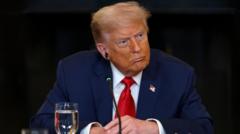Is Anyone Winning in Asia After Trump's Tariff Blitz?

Understanding the Implications of the Latest US Tariff Threat on Japan and Beyond
The trade landscape between the United States and its international partners has become increasingly complex, especially with the recent tariff threats posed by US President Donald Trump. Japan’s Prime Minister Shigeru Ishiba has publicly labeled these threats as “deeply regrettable,” reflecting the tension in a relationship that has historically been one of mutual cooperation. The implications of these tariffs extend beyond Japan, impacting numerous nations and altering global trade dynamics. In this article, we will explore the ramifications of these tariff threats, the responses from affected nations, and how they may affect future international relations.
The Context of US-Japan Trade Relations
Japan has long been a significant ally of the United States, with deep-rooted economic ties that span decades. The current tariff threats, including a proposed 25% levy on Japanese goods, have created a sense of urgency and concern in Tokyo. Japan has been diligently negotiating to protect its beleaguered automotive industry while resisting pressure to open its markets to American agricultural products, specifically rice.
Since Trump announced sweeping tariffs against various nations in April, Japan's trade minister has made multiple trips to Washington, D.C., attempting to broker an agreement that would stave off these tariffs. However, these negotiations have yielded little progress, and the situation has prompted a reevaluation of Japan’s strategy.
Lessons from Negotiation Attempts
Despite Japan’s efforts, the label placed on its negotiating stance has shifted markedly, moving from “tough” to “spoiled.” This change in rhetoric highlights the frustrations experienced during the negotiation process. The continued threat of tariffs places Japan, among other nations, in a precarious position as they scramble to adapt to the evolving demands of the US administration.
The Broader Impact on Asia
Japan is not alone in facing the repercussions of US tariff threats. A total of 22 nations, primarily in Asia, received tariff letters from the US. This includes countries like South Korea and Sri Lanka, which are heavily reliant on export-driven manufacturing. The deadline of August 1 for these nations to strike a deal with the US raises questions about their ability to negotiate favorable terms, especially when a major ally like Japan is still in a vulnerable position.
Optimism Amidst Uncertainty
On the surface, the extension of the tariff deadline may appear beneficial, as it allows countries additional time to engage in negotiations. However, the complexity of these trade agreements means that countries will likely require significant time to implement the changes demanded by the US. As highlighted by economists, the ambiguity surrounding which goods are affected by the tariffs complicates the negotiation process further.
For instance, the specifics around transhipped goods in Vietnam's trade deals present challenges in determining whether the levies apply to finished products or just components. This ambiguity can lead to delays as countries strive to clarify their positions and prepare adequate responses.
The Ripple Effects on Global Trade
The ongoing threat of tariffs has significant implications for global trade and economic stability. As countries like the US, Europe, and China navigate this landscape, many companies face heightened risks that can affect not only exporters but also importers and consumers within the US. The interconnected nature of international trade means that disruptions in one region can have cascading effects on others.
Identifying Winners and Losers
While it may be tempting to categorize countries as winners or losers in this tariff saga, the reality is far more nuanced. Vietnam, for example, may have secured an early agreement with the US, but it now faces tariffs as high as 40%. Similarly, Cambodia, with its limited economic leverage, is grappling with the threat of 35% tariffs.
In contrast, nations like South Korea and Japan, which possess greater economic resources and geopolitical clout, may have more room to maneuver. India's position remains uncertain, as it has yet to receive a tariff letter, but ongoing negotiations present their own challenges and sticking points, particularly regarding agricultural access.
The Future of US-Japan Relations
The current situation has the potential to transform US-Japan relations significantly. Japan’s refusal to meet certain US demands, particularly regarding military spending and agricultural imports, highlights its desire to maintain sovereignty over its economic policies. This stance has been bolstered by Japan’s economic preparedness, which includes establishing consultation centers to assist affected companies in navigating the turbulent waters of international trade.
Trade Negotiation Strategies
Japan's strategic approach to these negotiations is rooted in its historical expertise in trade diplomacy. As economist Jesper Koll notes, Japan is well-prepared for a prolonged negotiation process, particularly in light of its substantial financial reserves. This could position Japan to withstand pressures from the US and seek a more credible deal that aligns with its national interests.
The Long-Term Outlook
As Japan approaches its upper-house elections, the likelihood of reaching a comprehensive trade agreement by the August deadline appears slim. However, the absence of immediate resolution does not necessarily portend a recession in Japan. The country’s robust economic infrastructure and proactive measures indicate that it is prepared to endure and adapt to the ongoing challenges posed by US tariff threats.
China's Role in the Trade Landscape
Amidst the complexities of these negotiations, China remains a significant player in the global trade arena. As it navigates its own trade discussions with the US, the uncertainty created by US tariff threats may provide China with an opportunity to position itself as a stable alternative to the unpredictability of US trade policies. However, it is important to note that China also faces its own set of challenges and tensions with neighboring countries.
Conclusion: The Road Ahead
The evolving trade dynamics between the US and its partners underscore the intricate interplay of international relations, economics, and diplomacy. While tariffs may serve as a tool for negotiation, the long-term consequences can reshape established trade relationships built over decades. As various nations, particularly in Asia, strive to navigate this complex landscape, the outcome remains uncertain.
As we look to the future, it is clear that both the US and its trade partners face significant challenges in reaching mutually beneficial agreements. The landscape of international trade is evolving, and its implications will be felt for years to come. Will nations adapt and find solutions that foster cooperation, or will tensions escalate further? The race continues, and the stakes have never been higher.
FAQs
What are the implications of the US tariffs on Japan’s economy?
The US tariffs threaten to disrupt Japan's export-driven economy, particularly affecting its automotive industry and agricultural exports. Japan's ability to negotiate favorable terms may determine the extent of the economic impact.
How are other Asian countries responding to US tariff threats?
Countries like South Korea, Vietnam, and Cambodia are actively seeking to negotiate favorable agreements with the US to avoid significant tariffs. The complexity of the demands and the urgency of the deadline create a challenging situation for these nations.
Will Japan be able to withstand the pressure from the US?
Japan has demonstrated resilience through strategic preparation and negotiation tactics. Its historical experience in trade diplomacy and substantial financial reserves position it well to navigate ongoing pressures from the US.
As the global trade landscape continues to evolve, how do you see the future of international relations shaping up? #TradeWars #USJapanRelations #GlobalEconomy
Published: 2025-07-10 23:06:09 | Category: technology



